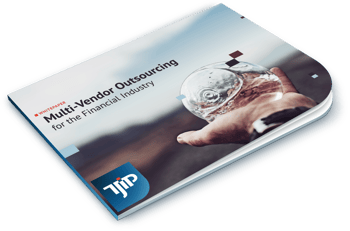It has long been our belief that our strength as a company resides in the way we’ve managed to manage multiple vendors and create a relationship of trust with our outsourcing partners. See also our case study in SlideShare.
Working with multiple vendors enables companies to draw from larger skill sets and expertise, expand on know-how and improve execution times, among many other benefits. It also allows for a much more focused business strategy, that leads to improved customer satisfaction and higher quality products and services.
Multi-vendor outsourcing has provided us with on demand access to quality assurance professionals , improved quality assurance processes, sped up the scalability of fintech software development team sizes and expertise, and made development costs more competitive.
There are several steps to be considered when working with multiple vendors, from selecting the right partners, to checking for compatibility, agreeing on a way of working and, finally, delivering a viable product/service. Let’s start with the first step.
1. Selecting the right vendors
Vendor selection is a critical initial step. For us, it’s important that we are compatible with the companies we’re going to partner with. This is a long-term investment that will define our brand and the level of quality of our products and services. A precondition for a sourcing partner is that they integrate with our team. We expect them to deliver their work with the same effort and interest as we do.
A good idea is to partner with companies that have previous experience in multi-vendor outsourcing, since they have a good idea of how collaborations work, and have defined clear responsibilities and modus operandi.
When selecting a new outsourcing partner, here are some key points where you should focus your attention:
- Good communication
- Up-to-date training
- Bridging cultural differences
- Controllable productivity
- Protection of intellectual property
- Compatibility of company mission and values
2. Checking for a cultural fit
Ensuring that there’s a cultural fit is paramount to our vendor selection process. A good fit can help minimize some of the risks that come with outsourcing and ensure better chances for fluid communication and a deeper understanding of each other’s ways of working.
A company’s culture guides their every action. It encompasses their values, beliefs and also their geographical culture. From a cultural standpoint, one company could be accustomed to always speaking their mind and pointing out issues that need resolving, while others will rely on common practice and the status quo, making it difficult to promote new ideas mid-project.
Hierarchical dynamics are also strongly influenced by culture and could become an advantage or a setback in your collaboration with that particular vendor.
3. Setting up a vendor management agreement
This type of agreement covers way of working, performance management and liability. Agreeing upon expectations and documenting them in such an agreement is crucial. It can be a service level agreement (SLA), an operating level agreement (OLA), an underpinning contract (UC) or even a combination of some of these.
Once a contract is signed and the collaboration defined, we introduce our new vendors as being a part of our company, without differentiating.
4. Defining an ongoing risk management plan
A lack of agility can mean missed opportunities and delays in resolving issues; That’s why it’s essential for us to put in place a risk management plan and to have one person responsible for implementing it.
5. Ensuring effective communication
Collaborating with multiple organisations always leads to some communication and planning issues. But with the modern tools available today, this is easily addressed. To integrate new vendors, we use online tools such as Skype or GoToMeeting that support real-time, daily communication.
The upside of having multiple vendors is the combined experience, and power, of everyone working on the project, which leads to designing better software.
Multiple vendor outsourcing has enabled us to honor our commitment to our customers and deliver quality software.
Together, we’ve amassed substantial expertise in financial software products and services, and we’re confident that these successful partnerships will continue for years to come, as we work together to understand business needs and deliver quality products.
If you’d like to find out more about TJIP’s outsourcing operating framework, download our Case Study On Multi-Vendor Outsourcing For The Financial Industry.
![Also read: Multi-Vendor outsourcing [Whitepaper]](https://no-cache.hubspot.com/cta/default/2537587/4c52deea-470d-423f-96c1-e1eda9c35425.png)
